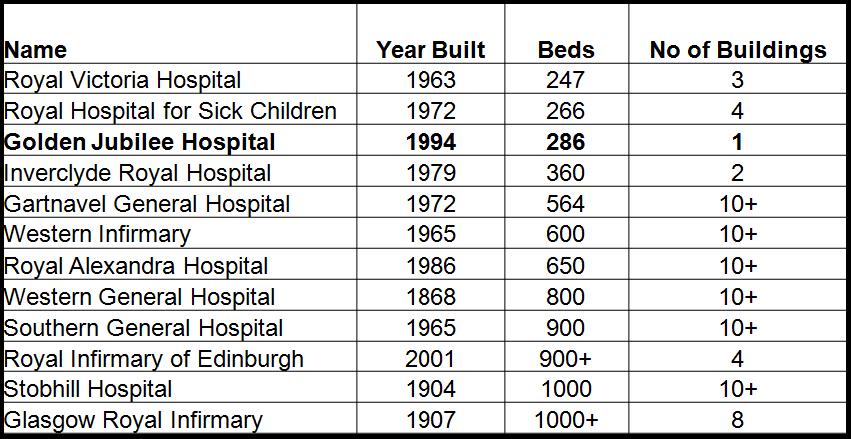Upgrading Strategies For Hospitals
(Golden Jubilee Hospital)
 |
 |
|
|
|
|
Contents |
General Hospital InformationAn investigation was carried out regarding UK hospitals to allow for an understanding of what is a "General UK Hospital". This investigation was looking at some of the similarities and differences in the composition. The table below shows the sample of hospitals that where considered along with some of the differing factors. From the data shown it is clear that The Golden Jubilee Hospital is slightly smaller than the average for the sample as well as the fact that it is the second most modern hospital in the group.  When considering energy improvements within hospitals it is key to identify the unique demands that a hospital provides. These demands can often cause an increase in the energy required to run the facility. Within hospitals the key objective is obviouslly the health and well being of the patients, with this in mind a variety of points to note are:
A good example of this unique requirement is explained in the comment below. "... For this reason heating in a health building should be 23 degC, i.e. 3 degC higher than the minimum recommended for office buildings, and any benchmark will need to take this into consideration. This 3 degC increase in temperature is in keeping with NHS and its use of 18.5 degC as the base degree day temperature as opposed to the standard 15.5 degC (PEFEX, 2005)." Another major issue with energy consumption within hospitals is the equipment used within the facility. A substantial part of the total energy consumption is used by the health care equipment (health monitors, surgical and dental equipment, etc.), necessary electrical equipment (refrigerators, washers, dryers, televisions, etc.) and other typical systems for the operation of a building (like elevators). This equipment and systems consume 13% and 8% of the annual average total energy consumed in hospitals and clinics, respectively. Understandably, these energy consumption sources are difficult to reduce and depend on the special function and operation of the health care buildings. In addition, considering the fact that some equipment in hospitals is operated on a continuous basis, it is understandable that their use will demand substantial amount of electrical energy. However, the selection of this equipment is done using other criteria than their energy consumption rates and therefor do not provide realistic oppertunities for reducing energy consumption, particularly in retro fit situations. |
Renewable Energy Systems & The EnvironmentGroup ProjectIt is the hope of the Energy Systems and Environment project team that the information contained in this website will contribute to the relevant field. Please feel free to use any of the findings presented to further your own study, making due acknowledgement where appropriate. |
|